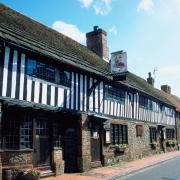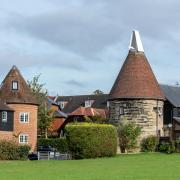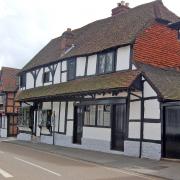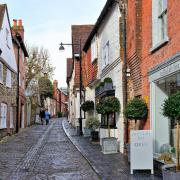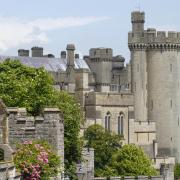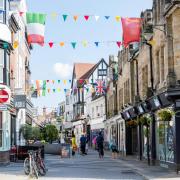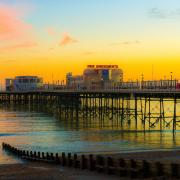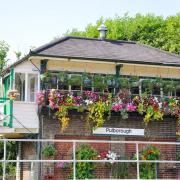All along the A27 there are calls for bypasses to ease congestion. But plans to deal with Arundel’s bottleneck have met with anger

It is a village that has been described as a little gem held in the past and unblemished by the modern world. Binsted, just south of the A27 between Chichester and Arundel, has no obvious centre, no village green with cottages grouped communally around it. There is a pub and a church but unusually they remain some distance apart. But this is a deeply historic landscape. The houses are scattered across the parish in the way things would have been in Saxon times. The open fields that would have been farmed in strips in medieval times are still traceable and there is historical parkland associated with the former manor house. There is extensive ancient woodland, bursting with bluebells in the spring and home to 14 species of bat as well as rare dormice and purple emperor butterflies. Locals call it a Noah’s ark of wildlife.
Now, in this rural utopia, a storm has gathered. In May Highways England announced that these open fields and areas of wildlife-rich woodland inside the South Downs National Park were the official preferred route for a new dual carriageway, the Arundel bypass. And construction could start in 2020.
Villagers are angry. Among them is Emma Tristram, who lives with her husband Mike close to Binsted Church. “The road would ruin the village,” she says. “It would be just 75 metres from three houses at one end, it would cut off four houses from the rest of the village and ten houses, some of them listed, would be just outside the 200-metre line. Many properties would be badly affected by noise.”
Emma says the best thing about living in Binsted is being able to walk across the fields into the surrounding woods. “The woods are fantastically good for wildlife and you are always seeing something new,” she says. And yet, at the western end of the proposed bypass, six hectares of ancient woodland containing an Iron Age earthwork would be flattened by the new road.
At the other end of the £250m, four-mile scheme, the dual carriageway would cross the River Arun and its water meadows to the south of Arundel, changing the view of the town.
The dual carriageway announcement has been met with little surprise. For a long time there have been rumblings for a bypass at Arundel, amplified during the 1980s and 1990s when other big road schemes were planned and built, such as the Newbury Bypass. It is true that the current route of the A27 through Arundel is plagued by pinchpoints, leading to congestion, but people have never agreed on how best to deal with the problem. Last year Highways England consulted with the public on three possible road-building schemes – the route now adopted with slight variations, dubbed Option 5A; Option 3 which would have had an even greater impact on ancient woodland; and a series of upgrades mainly along the existing line of the current A27, called Option 1 (see map overleaf). In the environmental camp, many comment that Option 3, with its huge impact on the environment, was never seriously in the picture and that for Highways England there was never any contest between the subtler elements of Option 1 and the big, bold, all-new dual carriageway offered by Option 5A.
Highways England says traffic is likely to grow in the future and that new roads are good for the economy: “By reducing congestion in the area, this scheme will improve journeys along the corridor between Brighton and Portsmouth, which is great news for the local and regional economy.”
Their position is supported by West Sussex County Council, Arun District Council and Arundel Town Council, although the town council vote was close. Nicholas Davis, from the county council, says: “Option 5A offers the best fit with the strategic outcomes that the council is seeking for the A27. It would have the most benefit for traffic and the economy.” At the district council Claire Pritchard adds: “The council believes this route will benefit the whole district by improving traffic flow and also supporting the future livelihood and success of businesses within the Arundel area.”
Local group OneArundel supports “the essential and long-overdue proposal for the building of an off-line, dual carriageway”, adding: “The A27 is one of the most unreliable all-purpose trunk roads in England and at Arundel the bottleneck causes congestion, delays, a high accident rate, air pollution, diversions onto unsuitable routes and it cuts the town into two halves.”
Others have written to the local press to show support for a new road, one calling the point of view in Binsted selfish and dismissing the village as “a long country cul-de-sac sparsely punctuated by a couple of dozen lavish properties”.
On the other side of the bitter division campaigners say support for a new dual carriageway is based on out-dated thinking. As well as questioning the connection between road-building and the economy, they argue it is no magic wand to deal with congestion either. Chris Todd represents national group Campaign for Better Transport. “You can’t build your way out of congestion,” he says. “New road space simply generates new traffic. It’s going to clog up the towns and cities at each end.”
Emma Tristram at Binsted is scathing about the decision-making process. So much so that she is fighting for a judicial review into it – an in-depth examination by a judge to establish whether the decision was made in a proper manner. “The consultation exercise with the public was inaccurate,” Emma says. “There was not enough good information for people to make an intelligent choice. They said the road would be 500 metres to the north of the village. That’s not true. The damage to Binsted Woods was hidden. The damage to Binsted Park was hidden. And even Highways England itself agrees it overstated the economic benefits and understated the ecological damage. So, by its own admission, Highways England gave out the wrong information.” If Emma can convince a judge that she is right, Highways England’s decision could be declared unlawful and the scheme thrown out.
The South Downs National Park Authority is also seeking a judicial review. Chair Margaret Paren says: “We are not commencing proceedings lightly but we believe Highways England has not followed the correct procedure, which was to set out, to the same level of detail, all of the options inside and outside the National Park. This led to them discounting options outside the National Park too early in the process.”
Emma adds. “If this dual carriageway gets built it will be a miscarriage of justice. As the threat of climate change worsens, it is not the time for building huge new road schemes.”
The other A27 road plans - by Chris Todd, Campaign for Better Transport (CBT)
• Chichester bypass - West Sussex County Council and Chichester District Council are pressing for a northern bypass. They are currently preparing a bid for the next round of road funding.
Cost: £350m-plus
CBT says: “A northern bypass would be highly damaging. The money would be better invested in improving public transport and creating a proper cycle network.”
• Worthing and Lancing scheme - Small-scale online improvements and some road widening are proposed. A May announcement was postponed at the last minute possibily due to local disatisfaction.
Cost: Up to £100m
CBT says: “The proposed scheme is too reliant on bigger roads, creating horrendous environments for pedestrians and cyclists.”
• Beddingham to Polegate scheme - Small-scale, online improvements are proposed between Beddingham Roundabout and Polegate, along with new cycle tracks. The preferred option was announced last year after a proposed Selmeston bypass was dropped.
Cost: About £70m
CBT says: “There is no focus on doing things differently, such as reducing traffic rather than generating more. It is a short-term solution in the absence of other measures.”
• East of Lewes scheme - A feasibility study was carried out this year to look at the possibility of a new dual carriageway from Polegate to Lewes, north of the existing A27. A business case is being developed for the next round of road funding.
Cost: £400m-£650m
CBT says: “This would be very damaging and would lead to more traffic, fuelling a never-ending demand for more roads. It would also cause significant damage to the South Downs National Park and the Low Weald.”








